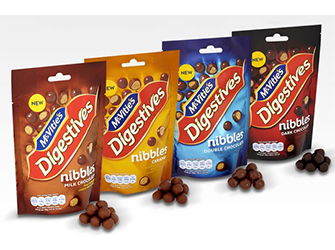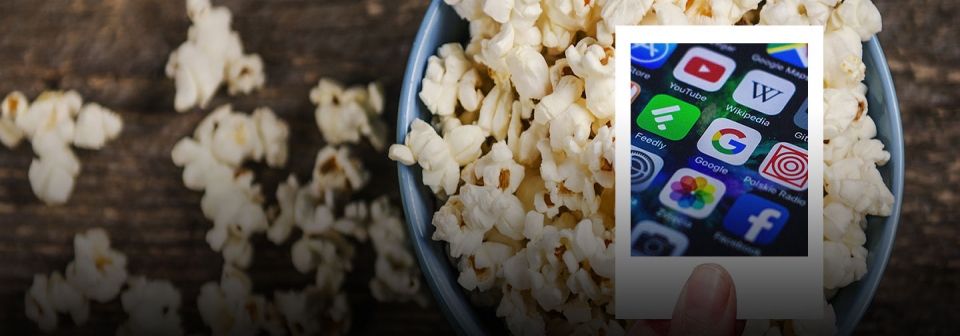The snack food industry is well-versed in psychology. To be successful, a brand must know that we nibble not just to satisfy our basic hunger, but also our emotional needs. Snack food brands have historically positioned their products to predict and ‘be there’ at the moment of a range of emotional states: fatigue, self-indulgence, comfort, boredom and pain.
But these moments are becoming increasingly ‘noisy’. Snacking choices and consumption patterns are changing, challenged by an increasing focus on health ( In 2016 38% of meals featured ingredients specifically chosen for health reasons) and, surprisingly, technology.
In 2016 38% of meals featured ingredients specifically chosen for health reasons) and, surprisingly, technology.
Think about it. When was the last time you sat down in front of the TV with just a bowl of popcorn in your hands? Or the last time you drowned your sorrows alone with a tub of ice cream after a bad day or break-up? Chances are these days you turn to your smartphone instead.
Our addiction to technology now tends to satisfy our psychological needs. Hands that are busy texting or gaming can’t reach for one’s favourite snack. Moments once spent deep in thought are interrupted by the call of social media. Globally, we spend on average 4.4 hours of our free time per day using a PC, laptop, tablet or mobile. Passive TV entertainment has given way to active engagement with multiple screens, presenting a real challenge to snack food manufacturers. How can they navigate their customer’s snacking needs, in a more active and new technology-heavy context?
 It’s time for snacking brands to re-think the moments to engage with a health conscious society.
It’s time for snacking brands to re-think the moments to engage with a health conscious society.
1. Cut through the noise...
To compete in a more stimulating environment, snack foods should ramp up the sensory hit they offer and understand the right moment to deliver it. Sharper flavours and formats can help cut through the noise at a moment when blander and more traditional snack foods might melt into the background.
A plethora of surprising, inventive flavours and textures are emerging to respond to the more adventurous palates of consumers. Increasing popularity of snacks like chilli chocolate, wasabi nuts and Bombay mix suggests people are lusting after harder-hitting, more exotic flavours. McCain’s have even created a potato scented bus stop to target hungry commuters, an example of the new trend in sensory based marketing.
Heritage cookie brand Oreo has traditionally kept to their staple black-cookie-with-creamy-centre product line. But as people crave ‘outside the box’ flavours more and more, Oreo has evolved to anticipate these moments to ensure customers don’t venture away in search of something more exciting. Instead of sticking to old comfort flavours, Oreo cookies now aim to surprise and delight their snackers, with new tastes such as popping candy and peanut butter.
2. Spot the moment ripe for product innovation
As people change their snacking behaviour, new opportunities arise for snack food brands to update and innovate around their product offers.
This could mean a very simple packaging format renovation, such as Walkers’ tear and share bag. Walkers effectively targeted ‘sharing’ moments with a handy design innovation that’s easier for groups of snackers to use.
McVitie’s Nibbles is a more game changing product innovation. The traditional biscuit in a smaller format facilitates sharing and plays on the senses in a way usually associated with ‘candy bites’.

Both brands effectively targeted the changing needs of consumers and re-thought the moments their product could be a part of, creating bold and unexpected products in response.
3. Be the main event
Smart snack brands are also placing themselves front and centre, facilitating moments between people instead of simply seeking to enhance them. Creating an immersive experience where your snack is central to the moment instead of accompanying another activity can create positive emotional associations and real-life moments. This could be anything from creating a pop up shop, to releasing recipes which include your product. As long as you are centre stage.
Luxury chocolate brands, are turning rich and indulgent snacks into indulgent experiences through the Magnum Pleasure Café, facilitating real-life moments whilst placing their brand front and centre.
4. Connect with today’s moments
Snacking has always been associated with real life touch points: a bag of Walkers Crisps with a packed lunch, or a KitKat during a break at work. However, consumers are becoming ever more time poor changing these needs and touchpoints. Building  associations with new moments can create a habit, redefine a mealtime or associate you with a different lifestyle choice .
associations with new moments can create a habit, redefine a mealtime or associate you with a different lifestyle choice .
Realising that many busy commuters skip breakfast, Belvita seized the moment to launch their breakfast biscuits, starting a trend that has been copied by many. By positioning their product in train station vending machines and designing something that is easy to eat on the go, the brand created a whole new snacking moment based around the morning dash to work.
Metcalf’s Popcorn built credibility for its positioning as a healthy snack by collaborating with the Nike Women’s 10km race and provided their popcorn in a goody bag. A snack available at this crucial moment creates associations between healthy lifestyle choices and this low calorie snack, as well as benefitting from a brand ‘halo effect’.
A new, active era for snacking
The rules for snacking have changed: needs, wants and habits are evolving to suit today’s hyper-connected and health conscious consumer. To reclaim some of the airtime lost to today’s customer’s lightning paced lives and addiction to technology, brands must understand the exact drivers that prompt us to pick up a bite to eat. Snack food brands who best understand our relationship with snacking, using deep insight to seize their unique moment, will cut through the noise.









